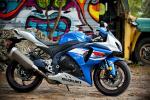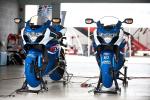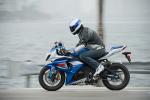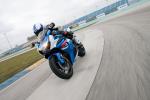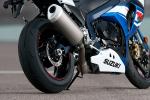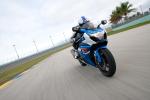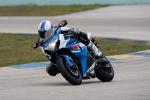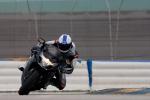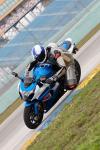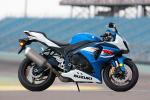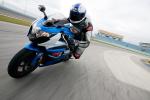Suzuki GSX-R1000 L2 2012
By Kevin Ash - 19/01/2013
The wheels of development are turning slow in Japan these days. While the Europeans are racing ahead, both technically and literally, so the once pace-setting GSX-R1000 has been treated to the mildest of facelifts for 2012.
The changes though, as with the 600, have leveraged performance gains beyond what you'd expect, and in part that's because a lot of us had forgotten what a cracking good motorcycle the 2011 GSX-R always was.
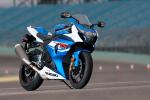
Ironically for a facelift model though, the face hasn't been lifted. Aside from some minor graphics changes (new stickers-), the bodywork is identical to the old. Nothing wrong with that per se as aside from its hooked nose, the GSX-R1000 is a good looking bike, although it does seem to indicate just how hard times are at Suzuki these days. But the 2012 Suzuki GSX-R1000 is recognisably different anyway, mostly because the previous twin silencer exhaust has been replaced by one with a single silenced and more compact pre-silencer chamber.
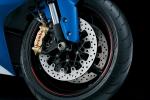
The gold Brembo Monobloc callipers at the front in place of the old Tokicos are the other clue that this is the latest model, though you're unlikely to spot that these grip 0.5mm thinner discs, that the front wheel spindle nut has changed, together saving a useful 130g unsprung weight, let alone that the seat material is different.
Overall Suzuki says the changes to the 2012 GSX-R1000 have resulted in a 4.4lb (2.0kg) weight loss, which given the deleted silencer and lighter front wheel assembly sounds rather conservative, so this could be a case of the company clawing back some of the past's more exaggerated weight claims. Whatever, it's also affected the bike's centre of gravity, which has moved forward by 1 per cent. The forks are 7mm shorter than before with 5mm less travel, but the preload has been increased to maintain the front ride height. They're also softer, to improve grip, while the only other chassis change is the fitment of Bridgestone's latest S20 tyres.

The engine's been treated to a package of upgrades, including new pistons which are 11 per cent lighter than before, designed to improve throttle response and reduce loads on other components. The valve recesses are smoother, helping combustion efficiency enough to allow a small increase in compression ratio to 12.9:1. The ventilation holes between the cylinders, below the pistons, have been reshaped from square to a pentagonal design, which Suzuki says significantly improves the low of air between cylinders, reducing pumping losses.
The exhaust cams feature new profiles which draw on Suzuki's MotoGP technology, and the overlap was reduced. While peak horsepower is unaffected, the aim was to make the mid-range is stronger, particularly between 6000-7000rpm where there was something of a dip on the older model. New valve buckets are 2.5g lighter, helping reduce reciprocating weight and the stresses on the valve train, useful on a big engine which revs to 13,500rpm.

Swing a leg over the still familiar looking machine and it feels much the same as before too. You'd probably notice the weight difference stepping directly from old to new, but it's not something I could tell in isolation. The venue for the test was the Homestead NASCAR circuit, although we used the twisting infield and two straights but not the banked curves of the high speed oval. Some dampness initially, combined with annoying lower-grip concrete sections set into the apexes of several corners, affected confidence at first, as did the fact that I broke my wrist sliding off a GSX-R600 at this track 13 years ago!
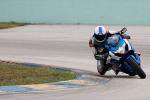
The GSX-R1000 though is a good place to gain trust in a track. It doesn't have quite the plugged in, natural feel of a Fireblade, but it's not far off, especially after you've had some time to learn the best way to ride it. The initial turn-in is quite heavy, very typical of big piston forks which dip less than conventional ones on the initial application of the brakes, resulting in a reduced geometry change. You need to put some muscle into getting the bike over for a turn, but once it's leaning and cornering, it's sensitive to bar input and you have to be careful how much pressure you apply. I found it difficult at first to follow exactly the line I wanted through turns, especially if I was running slightly wide and wanted to pull it in tighter, but when I'd dialled in to what the bike preferred, I relaxed and it became thoroughly enjoyable.
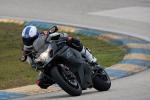
The odd slide, usually over one of those concrete patches, was benign and easily corrected, while getting the back end a little lose driving out of corners wasn't unnerving either. There's no traction control safety net on the 2012 Suzuki GSX-R1000, and while it would be better for it in most riders' hands, it's not sorely missed either.
The brakes themselves are as good as we've come to know on many other bikes, with immense yet very controllable power, no sign of fade even after many laps on the track, and importantly they release very smoothly and progressively as you're leaning into the turn. Stopping has been something of a weakness of several GSX-R Suzukis in recent years, but you certainly couldn't accuse the 2012 GSX-R1000 of that now.
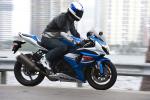
Out on the roads we were given the original S20s to use - for the circuit, Bridgestone R10s were fitted, but it's hard to tell if the bike steers very differently with these as this was Florida and there weren't any corners on our route to try them out properly. Oh yes, and much less expected in Florida it poured with rain too- The suspension coped well with variable road conditions though. It has a firm feel but surprising compliance when it gets bumpy, and comfort is as you were with the 2011 bike, a spacious riding position for modern superbike, not too much weight on the wrists and reasonable wind protection.
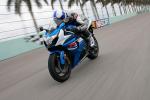
What is noticeable on road and track is the more muscular mid-range. There's still a kick in the power at around 8,000rpm but the lead up to that is more progressive and predictable, great for driving out of turns and effective for charging past cars on the road. There's less power at the bottom end than before, below 4,000rpm, but this was less of a problem than I was anticipating as at these revs and road speeds you're using only a light throttle most of the time anyway. On the track it's irrelevant. The engine also makes a fabulous snarling sound, deep and bubbling at lower revs, angry and noisy when being spun fast - this really adds to the experience and imbues the bike with some character.
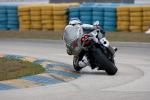
Less welcome is the vibration. You don't notice it so much on the track, although even there it can start to numb the odd digit or two, but on the road at a steady speed it can be tingling and intrusive, especially at higher motorway speeds such as 90mph (145kph). A raw edge to an engine can be a good thing, but when it includes this much vibration it's going to spoil rather than enhance the experience. It's worse than I remember of the 2011 model so presumably the dynamic change due to the lighter pistons is behind it, or perhaps even the lighter valve buckets.
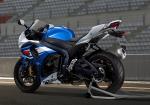
No one was expecting the 2012 Suzuki GSX-R1000 to trump bikes like the Aprilia RSV4 or S1000RR, but as a road bike there are convincing traits that make it a better bet, such as the mid-range power, the better ergonomics, the general ease of riding and the sheer character of the bike. It's £300 cheaper than a Fireblade and the fuel economy is better than the 2011 GSX-R1000 too, meaning it should have a pretty useful range. It's also still a searingly rapid track machine, with sharp handling and telegraphic feedback, so at the price it's well worth considering and will be a rewarding machine to own. Those vibes are going to annoy some riders though.

Specifications
Price: £10,999”
Available: end of February 2012
”Engine: four cylinder, liquid cooled, dohc 16v, 999cc”
Power: 183bhp (185PS, 136kW) @ 11,500rpm”
Torque: 86lb.ft (11.9kgm, 117Nm) @ 10,000rpm”
Economy: n/a mpg”
Tank/Range: 3.85 gallon (17.5 litre, 4.62 gallons US)/ n/a miles”
Transmission: Six gears, wet slipper clutch, chain final drive”
Chassis: Twin spar aluminium
Seat height: 31.9in (810mm)”
Wheelbase: 55.3in (1405mm)”
Rake/trail: 23.5 °/ 3.86in (98mm)”
Weight: 448lb (203kg) (wet)
Donate to the Kevin Ash Fund
Kevin's funeral was held on Thursday 28th February 2013 and was well attended by family, friends and colleagues.
The Telegraph has very kindly established The Telegraph Kevin Ash Fund to assist with the education of Kevin's three daughters.
If you'd like to make a donation then you can use the PayPal 'Donate' button below which will allow you to donate from your PayPal account, or via credit or debit card. A small percentage (about 3.4%) will be retained by PayPal for the service.
Kevin's family have been touched by the generosity and messages of support from people using the website and would like to express their gratitude to those who have contributed in any way.
The donations keep coming in, thank you so much, and the family especially like it when you leave a message.
Home | ![]() facebook.com/KevinAshFund
|
facebook.com/KevinAshFund
| ![]() twitter.com/KevinAshFund | © 2013
twitter.com/KevinAshFund | © 2013
